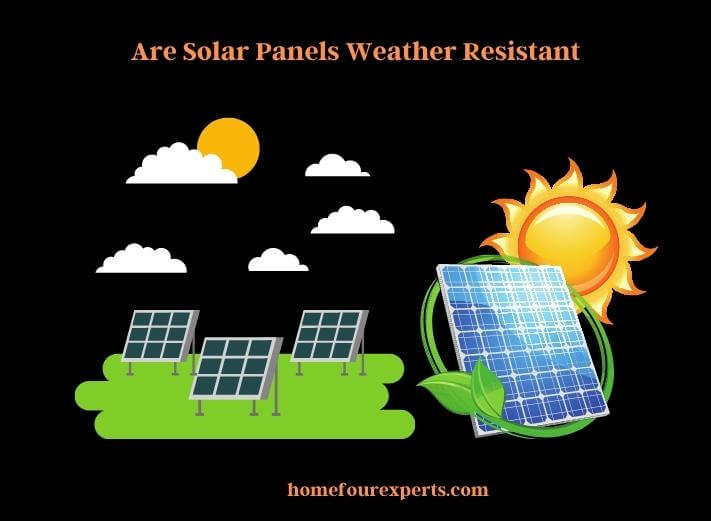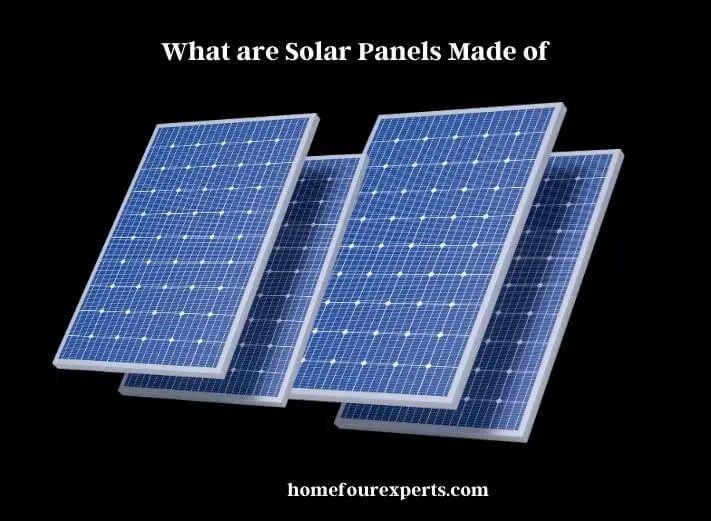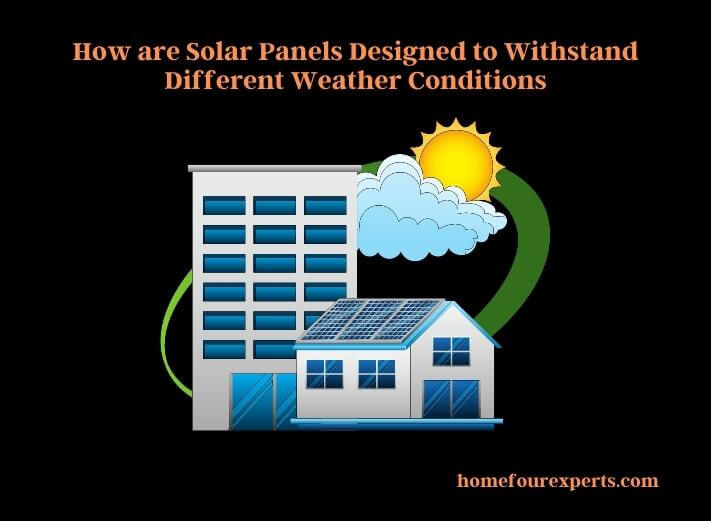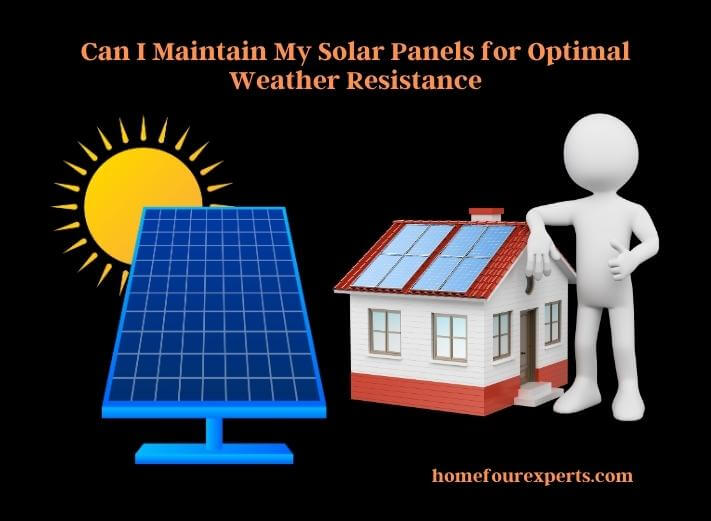Solar energy is a clean and renewable source of energy that is gaining popularity around the world. With the increasing demand for sustainable and eco-friendly energy sources, more people are turning to solar panels as a viable option.

Some people may have concerns about the weather resistance of solar panels, especially in regions that experience extreme weather conditions. In this article, we will explore whether solar panels are weather-resistant and how they can be maintained to ensure their longevity and efficiency. We will also address some common FAQs about solar panels and their weather resistance.
What are Solar Panels Made of?
Solar panels are made of photovoltaic cells, which are usually made of silicon. Silicon is a semiconductor material that is commonly used in electronics because of its ability to conduct electricity. When photons from the sun’s rays hit the solar panel’s surface, they knock electrons off the silicon atoms, creating a flow of electricity.
The photovoltaic cells are then placed on a panel and covered with a layer of protective glass. This glass layer protects the cells from damage and also helps to increase their efficiency by allowing maximum sunlight to pass through.

Silicon, some solar panels may also contain other materials, such as copper, aluminum, and various types of conductive metals. These materials help to connect the cells and ensure that the electricity generated by the cells is efficiently transferred to the power grid or storage batteries.
Solar panels are made up of high-quality materials that are designed to withstand various weather conditions and maintain their efficiency over time. With proper maintenance and care, solar panels can last for decades and provide a reliable source of renewable energy.
Types of Weather Conditions that Solar Panels can Withstand
Wind
Solar panels are designed to withstand different wind speeds depending on the type of panel and its installation location. Most panels are rated to withstand winds of up to 90 miles per hour. Some panels can withstand winds of up to 140 miles per hour, making them suitable for use in hurricane-prone areas.
Rain and Snow
Solar panels are designed to withstand rain and snow. They are made of materials that are water-resistant, and their design ensures that water does not accumulate on the panel’s surface. In snowy areas, solar panels are often installed at an angle to allow snow to slide off easily.

Hail
Hail can be a significant threat to solar panels. However, most panels are designed to withstand the impact of hailstones of up to 1 inch in diameter. In areas prone to larger hailstones, homeowners may opt for panels that can withstand larger impacts.
Extreme Temperatures
Solar panels are designed to function in extreme temperatures. They are tested to operate in temperatures ranging from -40 degrees Fahrenheit to 185 degrees Fahrenheit. In extreme temperatures, solar panels may produce slightly less electricity, but they will not be damaged.
If you want to know how to measure a trampoline, See here for more explanation.
How are Solar Panels Designed to Withstand Different Weather Conditions?
Wind Resistance
Solar panels are designed to withstand different wind speeds depending on their location. Panels installed in hurricane-prone areas are designed to withstand winds of up to 140 miles per hour. Panels installed in areas with less wind activity are designed to withstand winds of up to 90 miles per hour. Panels are anchored to the roof or ground to ensure that they remain stable during strong winds.

Water Resistance
Solar panels are made of materials that are water-resistant. The panels’ design ensures that water does not accumulate on the panel’s surface. In addition, the panels are often installed at an angle to allow water to run off easily.
Impact Resistance
Solar panels are designed to withstand impacts from hailstones and other objects. They are tested to withstand impacts of up to 1 inch in diameter. In areas prone to larger hailstones, homeowners may opt for panels that can withstand larger impacts.
Temperature Tolerance
Solar panels are designed to function in extreme temperatures. They are tested to operate in temperatures ranging from -40 degrees Fahrenheit to 185 degrees Fahrenheit. The panels are made of materials that can expand and contract without cracking or breaking.
Maintaining Weather Resistance of Solar Panels
Cleaning the Panels Regularly
To ensure that solar panels remain weather-resistant, they need to be cleaned regularly. Dirt, debris, and bird droppings can accumulate on the panel’s surface, which can reduce its efficiency. Regular cleaning can help maintain the panel’s performance and extend its lifespan.
Monitoring the Panels
It is important to monitor the solar panels regularly to ensure that they are functioning properly. This can be done by checking the panel’s output regularly and noting any significant changes. If the panel’s output drops significantly, it may indicate that there is a problem with the panel.
Hiring Professionals
Solar panels should be installed and maintained by professionals to ensure that they are weather-resistant. Professionals have the knowledge and expertise to ensure that the panels are installed correctly and maintained properly. They can also provide advice on how to protect the panels from extreme weather conditions.
Can I Maintain My Solar Panels for Optimal Weather Resistance?
Yes, you can maintain your solar panels for optimal weather resistance by following some simple guidelines. Regular maintenance is important to ensure the longevity and efficiency of your solar panels. Here are some tips to help you maintain your solar panels:

- Clean your panels regularly: Solar panels should be cleaned regularly to remove dust, dirt, and debris that may accumulate on the surface. You can use a soft brush or sponge with soap and water to clean the panels, but avoid using abrasive materials that may scratch the surface.
- Inspect for damage: Check your panels periodically for signs of damage or wear and tear, such as cracks, chips, or discoloration. If you notice any damage, contact a professional to have it repaired as soon as possible.
- Trim nearby trees: Trees and other obstructions can block sunlight from reaching your panels, reducing their efficiency. Keep nearby trees trimmed to ensure maximum sunlight exposure.
- Monitor performance: Keep track of your solar panel’s performance over time to ensure they are generating the expected amount of electricity. If you notice a drop in performance, it may be a sign that your panels need maintenance or repairs.
- Hire a professional: It’s a good idea to have a professional inspect your panels periodically to ensure they are functioning properly and to address any issues that may arise.
By following these guidelines, you can help ensure that your solar panels are well-maintained and perform optimally in various weather conditions.
Final Thoughts
Solar panels can be a reliable source of renewable energy for homes and businesses, but their durability and resistance to weather conditions are important factors to consider when choosing a solar panel system. While solar panels are designed to withstand various weather events, regular maintenance is key to ensuring their longevity and efficiency.
Solar panels are made up of various materials, including silicon cells, glass, and aluminum frames. These materials are chosen for their durability and resistance to weather conditions such as rain, hail, wind, and extreme temperatures. The extent to which solar panels can withstand weather conditions can vary depending on their quality and durability.
One of the advantages of solar panels is that they can provide clean and renewable energy without emitting greenhouse gases or other harmful pollutants. Additionally, solar energy can save money on energy bills and reduce dependence on non-renewable sources of energy.
There are also some disadvantages to solar panels, such as their high initial cost and the need for adequate sunlight exposure to generate electricity. Additionally, some solar panels may not be as durable or weather-resistant as others, making it important to choose a high-quality system and maintain it properly over time.
About This Writer

Hi, I am responsible for the 'Homeowners Power Solutions' category. My name is Liam Jaxon and a licensed technician with 7 years of experience in vehicle batteries, electrical gadgets, and home appliances. My working experience in different residential & light commercial electrical sectors and the automobile industry helped to acquire vast knowledge in this industry.